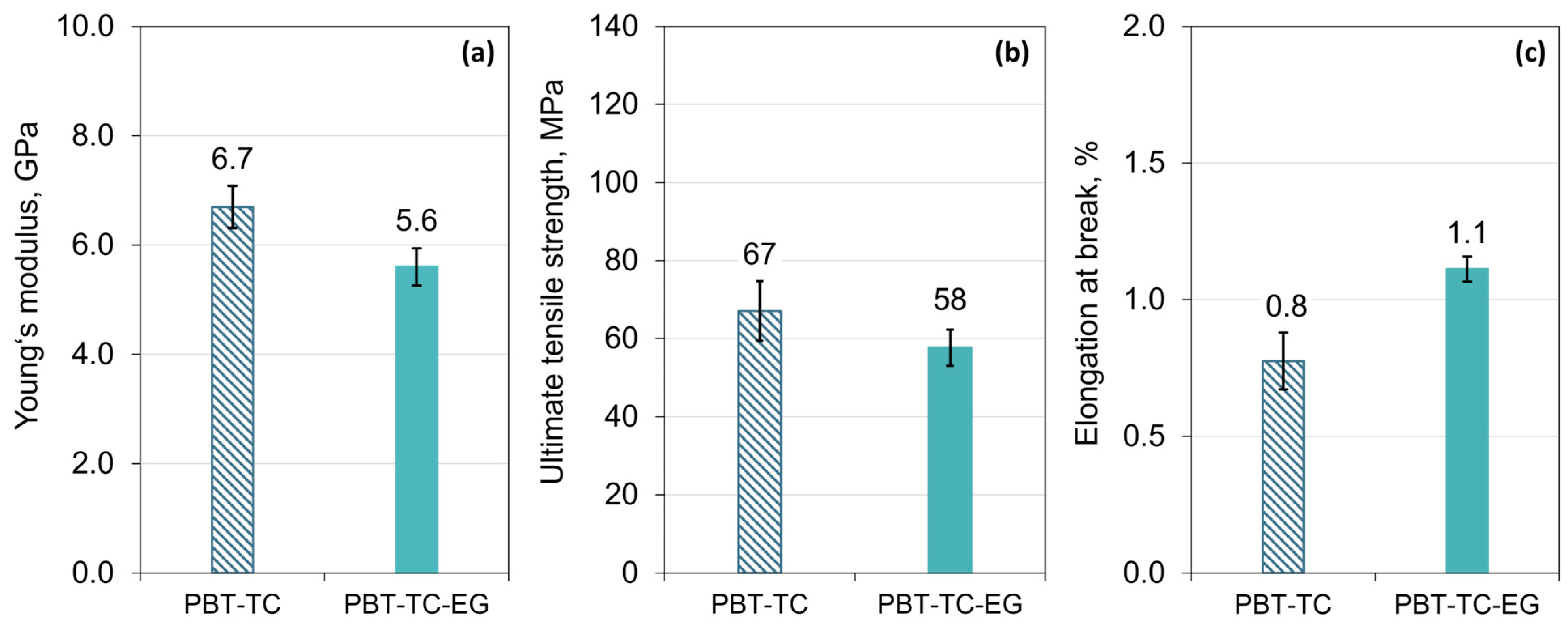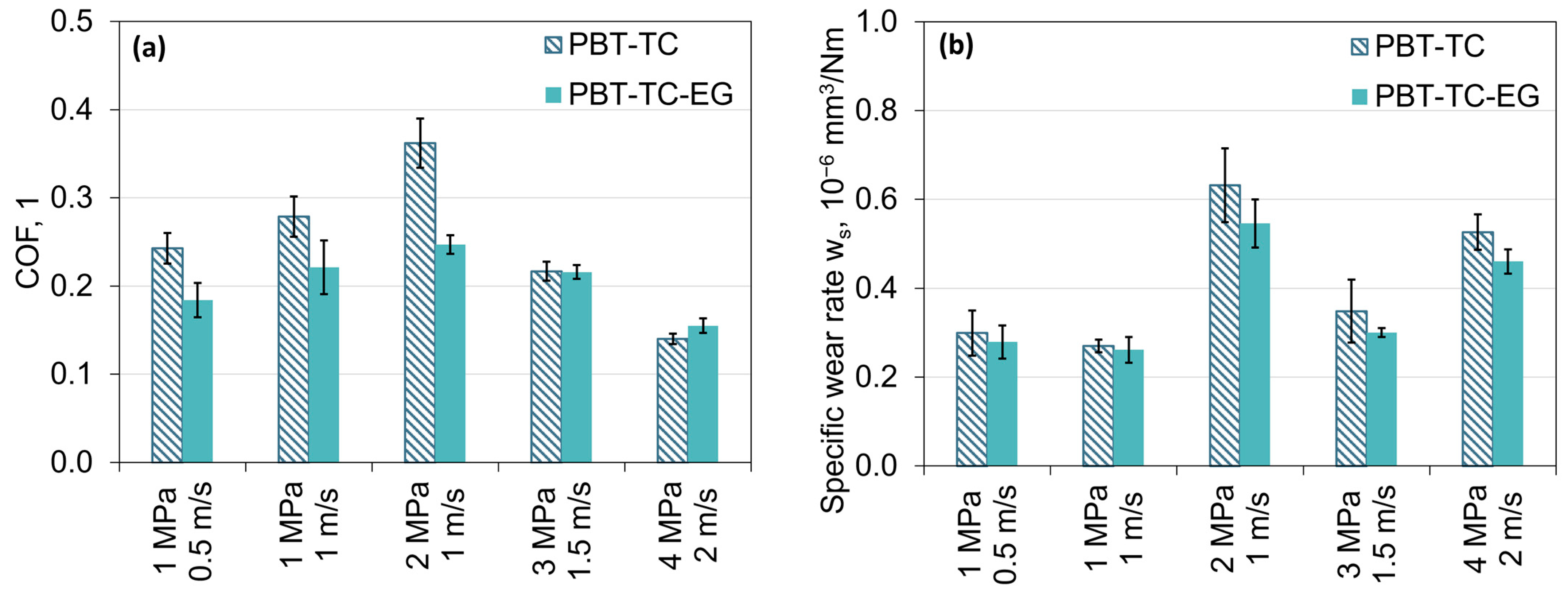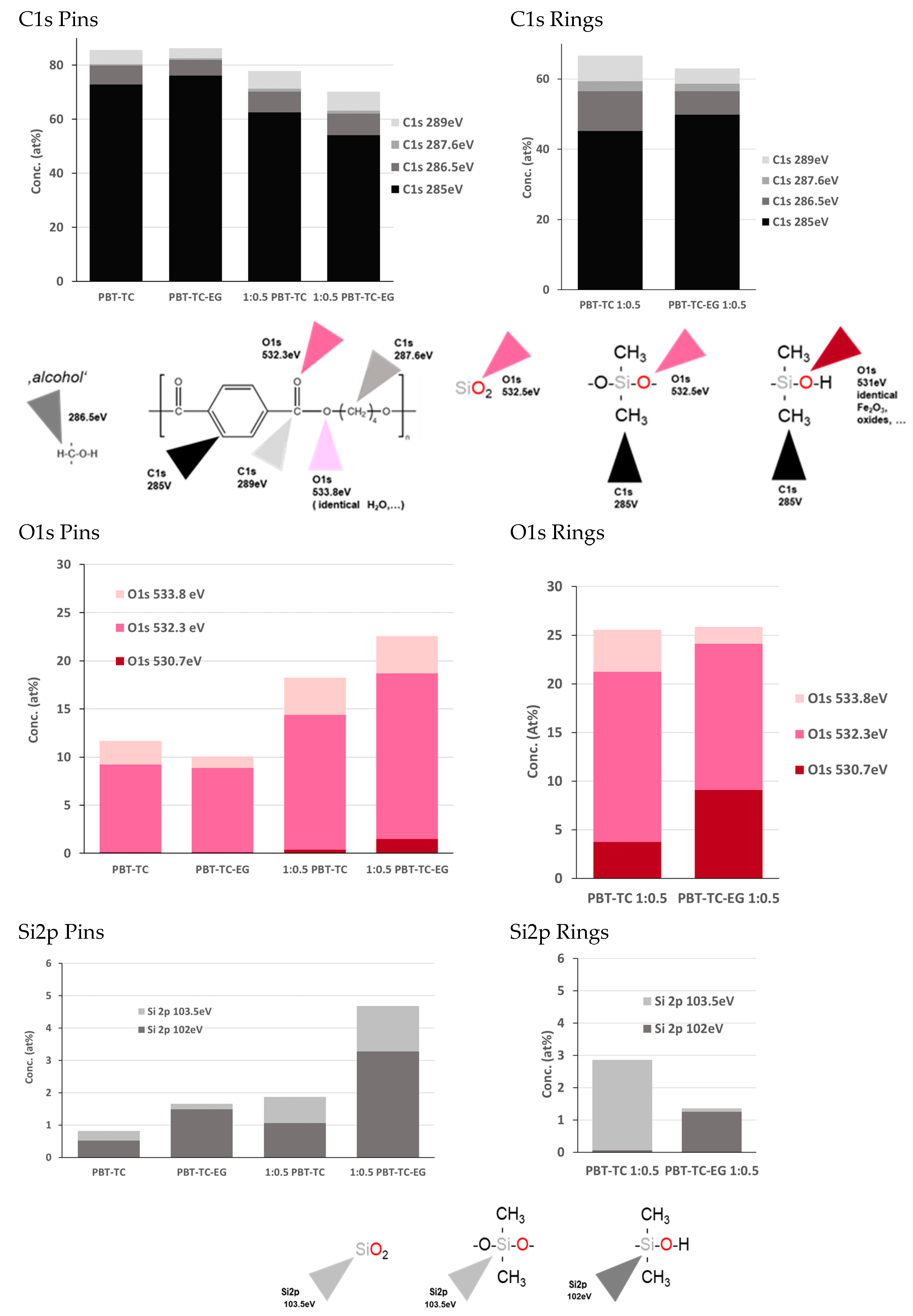Improved Tribological Performance of a Polybutylene Terephthalate Hybrid Composite by Adding a Siloxane-Based Internal Lubricant
Abstract
:1. Introduction
2. Experimental
2.1. Materials and Composites Manufacturing
2.2. Mechanical Investigations
2.3. Tribological Studies
2.4. Chemical Characterization
3. Results and Discussion
3.1. Mechanical Properties
3.2. Tribological Properties
3.3. Chemical Characterizations
3.3.1. Elemental Concentrations of Composite Pins
3.3.2. Elemental Concentrations of the Ring Samples
3.3.3. Chemical Binding Situation at Pins and Rings in Comparison
4. Conclusions
Author Contributions
Funding
Data Availability Statement
Acknowledgments
Conflicts of Interest
References
- Dorri Moghadam, A.; Omrani, E.; Menezes, P.L.; Rohatgi, P.K. Mechanical and tribological properties of self-lubricating metal matrix nanocomposites reinforced by carbon nanotubes (CNTs) and graphene—A review. Compos. Part B Eng. 2015, 77, 402–420. [Google Scholar] [CrossRef]
- Friedrich, K. Polymer composites for tribological applications. Adv. Ind. Eng. Polym. Res. 2018, 1, 3–39. [Google Scholar] [CrossRef]
- Cooper, B.G.; Catalina Bordeianu Nazarian, A.; Snyder, B.D.; Grinstaff, M.W. Active agents, biomaterials, and technologies to improve biolubrication and strengthen soft tissues. Biomaterials 2018, 181, 210–226. [Google Scholar] [CrossRef]
- Liu, H.; Su, X.; Tao, J.; Fu, R.; You, C.; Chen, X. Effect of SiO2 nanoparticles-decorated SCF on mechanical and tribological properties of cenosphere/SCF/PEEK composites. J. Appl. Polym. Sci. 2020, 137. [Google Scholar] [CrossRef]
- Yang, Z.; Yang, Y.; Wang, H.; Liu, F.; Lu, Y.; Ji, L.; Wang, Z.L.; Cheng, J. Charge Pumping for Sliding-mode Triboelectric Nanogenerator with Voltage Stabilization and Boosted Current. Adv. Energy Mater. 2021, 11, 2101147. [Google Scholar] [CrossRef]
- Zhong, L.; Zhang, W.; Sun, S.; Zhao, L.; Jian, W.; He, X.; Xing, Z.; Shi, Z.; Chen, Y.; Alshareef, H.N.; et al. Engineering of the Crystalline Lattice of Hard Carbon Anodes Toward Practical Potassium-Ion Batteries. Adv. Funct. Mater. 2022, 33, 2211872. [Google Scholar] [CrossRef]
- Privitera, V.; Scalese, S.; La Magna, A.; Pecora, A.; Cuscunà, M.; Maiolo, L.; Minotti, A.; Simeone, D.; Mariucci, L.; Fortunato, G.; et al. Low-Temperature Annealing Combined with Laser Crystallization for Polycrystalline Silicon TFTs on Polymeric Substrate. J. Electrochem. Soc. 2008, 155, H764. [Google Scholar] [CrossRef]
- Bretos, I.; Jiménez, R.; Wu, A.; Kingon, A.I.; Vilarinho, P.M.; Calzada, M.L. Activated solutions enabling low-temperature processing of functional ferroelectric oxides for flexible electronics. Adv. Mater. 2014, 26, 1405–1409. [Google Scholar] [CrossRef] [PubMed]
- Chernets, M.; Shil’ko, S.; Kornienko, A. Calculated assessment of contact strength, wear and resource of metal-polymer gears made of dispersion- reinforced composites. Appl. Eng. Lett. 2021, 6, 54–61. [Google Scholar] [CrossRef]
- Marković, A.; Ivanović, L.; Stojanović, B. Characteristics, Manufacturing, and Testing Methods of Polymer Gears: Review. Lect. Notes Netw. Syst. 2024, 866, 269–282. [Google Scholar] [CrossRef]
- Singh, P.K.; Siddhartha Singh, A.K. An investigation on the thermal and wear behavior of polymer based spur gears. Tribol. Int. 2018, 118, 264–272. [Google Scholar] [CrossRef]
- Yang, Z.; Guo, Z.; Yuan, C. Tribological behavior of polymer composites functionalized with various microcapsule core materials. Wear 2019, 426–427, 853–861. [Google Scholar] [CrossRef]
- Yang, Z.; Guo, Z.; Yang, Z.; Wang, C.; Yuan, C. Study on tribological properties of a novel composite by filling microcapsules into UHMWPE matrix for water lubrication. Tribol. Int. 2021, 153, 106629. [Google Scholar] [CrossRef]
- Hale, W.R.; Pessan, L.A.; Keskkula, H.; Paul, D.R. Effect of compatibilization and ABS type on properties of PBT/ABS blends. Polymer 1999, 40, 4237–4250. [Google Scholar] [CrossRef]
- Soudmand, B.H.; Shelesh-Nezhad, K. Study on the gear performance of polymer-clay nanocomposites by applying step and constant loading schemes and image analysis. Wear 2020, 458–459, 203412. [Google Scholar] [CrossRef]
- Wang, Z.; Gao, D. Comparative investigation on the tribological behavior of reinforced plastic composite under natural seawater lubrication. Mater. Des. 2013, 51, 983–988. [Google Scholar] [CrossRef]
- Stead, I.M.N.; Eckold, D.G.; Clarke, H.; Fennell, D.; Tsolakis, A.; Dearn, K.D. Towards a plastic engine: Low—Temperature tribology of polymers in reciprocating sliding. Wear 2019, 430–431, 25–36. [Google Scholar] [CrossRef]
- Advincula, P.A.; Granja, V.; Wyss, K.M.; Algozeeb, W.A.; Chen, W.; Beckham, J.L.; Luong, D.X.; Higgs, C.F., III; Tour, J.M. Waste plastic- and coke-derived flash graphene as lubricant additives. Carbon 2023, 203, 876–885. [Google Scholar] [CrossRef]
- Martín-Alfonso, J.E.; Valencia, C.; Sánchez, M.C.; Franco, J.M.; Gallegos, C. Evaluation of different polyolefins as rheology modifier additives in lubricating grease formulations. Mater. Chem. Phys. 2011, 128, 530–538. [Google Scholar] [CrossRef]
- Bheemappa, S.; Gurumurthy, H.; Badami, V.V.; Hegde, P.R. Tribological Behavior of Polymeric Systems in Lubricated Surfaces or Conditions; Elsevier: Amsterdam, The Netherlands, 2022. [Google Scholar] [CrossRef]
- Hlebanja, G.; Hriberšek, M.; Erjavec, M.; Kulovec, S. Durability Investigation of plastic gears. MATEC Web Conf. 2019, 287, 02003. [Google Scholar] [CrossRef]
- Rodiouchkina, M.; Lind, J.; Pelcastre, L.; Berglund, K.; Rudolphi, Å.K.; Hardell, J. Tribological behaviour and transfer layer development of self-lubricating polymer composite bearing materials under long duration dry sliding against stainless steel. Wear 2021, 484–485, 204027. [Google Scholar] [CrossRef]
- Samyn, P.; De Baets, P.; Schoukens, G. Influence of internal lubricants (ptfe and silicon oil) in short carbon fibre-reinforced polyimide composites on performance properties. Tribol. Lett. 2009, 36, 135–146. [Google Scholar] [CrossRef]
- Ben Difallah, B.; Kharrat, M.; Dammak, M.; Monteil, G. Mechanical and tribological response of ABS polymer matrix filled with graphite powder. Mater. Des. 2012, 34, 782–787. [Google Scholar] [CrossRef]
- Bashandeh, K.; Lan, P.; Meyer, J.L.; Polycarpou, A.A. Tribological Performance of Graphene and PTFE Solid Lubricants for Polymer Coatings at Elevated Temperatures. Tribol. Lett. 2019, 67, 99. [Google Scholar] [CrossRef]
- Sajid, M.; Ilyas, M. PTFE-coated non-stick cookware and toxicity concerns: A perspective. Environ. Sci. Pollut. Res. 2017, 24, 23436–23440. [Google Scholar] [CrossRef] [PubMed]
- Sony, M.; Naik, S. Green Lean Six Sigma implementation framework: A case of reducing graphite and dust pollution. Int. J. Sustain. Eng. 2020, 13, 184–193. [Google Scholar] [CrossRef]
- Hazaimeh, M.D.; Ahmed, E.S. Bioremediation perspectives and progress in petroleum pollution in the marine environment: A review. Environ. Sci. Pollut. Res. 2021, 28, 54238–54259. [Google Scholar] [CrossRef] [PubMed]
- Yu, C.; Liao, Y.; Zhang, P.; Li, B.; Li, S.; Wang, Q.; Li, W. Polyimide-based composite coatings for simultaneously enhanced mechanical and tribological properties by polyhedral oligomeric silsesquioxane. Tribol. Int. 2022, 171, 107521. [Google Scholar] [CrossRef]
- Chen, Z.; Zhang, M.; Guo, Z.; Chen, H.; Yan, H.; Ren, F.; Jin, Y.; Sun, Z.; Ren, P. Synergistic effect of novel hyperbranched polysiloxane and Ti3C2Tx MXene/MoS2 hybrid filler towards desirable mechanical and tribological performance of bismaleimide composites. Compos. Part. B Eng. 2023, 248, 110374. [Google Scholar] [CrossRef]
- DIN EN ISO 527-2:2012; Kunststoffe—Bestimmung der Zugeigenschaften—Teil 2: Prüfbedingungen für Form- und Extrusionsmassen. Deutsche Fassung EN ISO: Berlin, Germany, 2012.
- ASTM G77-17; Standard Test Method for Ranking Resistance of Materials to Sliding Wear Using Block-on-Ring Wear Test. ASTM: West Conshohocken, PA, USA, 2022.
- NIST X-ray Photoelectron Spectroscopy Database. NIST Standard Reference Database Number 20. Natl. Inst. Stand. Technol. 2023. Available online: https://srdata.nist.gov/xps/ (accessed on 14 March 2024).
- Piscitelli, F.; Lavorgna, M.; Buonocore, G.G.; Verdolotti, L.; Galy, J.; Mascia, L. Plasticizing and reinforcing features of siloxane domains in amine-cured epoxy/silica hybrids. Macromol. Mater. Eng. 2013, 298, 896–909. [Google Scholar] [CrossRef]
- Mathew, A.; Kurmvanshi, S.; Mohanty, S.; Nayak, S.K. Preparation and characterization of siloxane modified: Epoxy terminated polyurethane-silver nanocomposites. Polym. Compos. 2018, 39, E2390–E2396. [Google Scholar] [CrossRef]
- Arzhakov, M.S.; Arzhakov, S.A.; Gustov, V.V.; Kevdina, I.B.; Shantarovich, V.P. Structural and mechanical behavior of polymethylmethacrylate containing diethyl siloxane oligomer. Int. J. Polym. Mater. Polym. Biomater. 1998, 39, 319–333. [Google Scholar] [CrossRef]
- Li, S.; Wang, H.; Liu, M.; Peng, C.; Wu, Z. Epoxy-functionalized polysiloxane reinforced epoxy resin for cryogenic application. J. Appl. Polym. Sci. 2019, 136, 46930. [Google Scholar] [CrossRef]
- Qi, H.; Zhang, G.; Chang, L.; Zhao, F.; Wang, T.; Wang, Q. Ultralow Friction and Wear of Polymer Composites under Extreme Unlubricated Sliding Conditions. Adv. Mater. Interfaces 2017, 4, 1601171. [Google Scholar] [CrossRef]
- Grey, L.H.; Nie, H.Y.; Biesinger, M.C. Defining the nature of adventitious carbon and improving its merit as a charge correction reference for XPS. Appl. Surf. Sci. 2024, 653, 159319. [Google Scholar] [CrossRef]
- Hua, C.; Zhao, S.; Lin, L.; Schlarb, A.K. Tribological performance of a polyethersulfone (PESU)-based nanocomposite with potential surface changes of the metallic counterbody. Appl. Surf. Sci. 2023, 636, 157850. [Google Scholar] [CrossRef]
- Zhao, S.; Hua, C.; Zhao, Y.; Sun, C.; Lin, L. Casting of regulable nanostructured transfer film by detaching nanofiller from the composite into the tribosystem—A strategy to customize tribological properties. Tribol. Int. 2024, 195, 109597. [Google Scholar] [CrossRef]






Disclaimer/Publisher’s Note: The statements, opinions and data contained in all publications are solely those of the individual author(s) and contributor(s) and not of MDPI and/or the editor(s). MDPI and/or the editor(s) disclaim responsibility for any injury to people or property resulting from any ideas, methods, instructions or products referred to in the content. |
© 2024 by the authors. Licensee MDPI, Basel, Switzerland. This article is an open access article distributed under the terms and conditions of the Creative Commons Attribution (CC BY) license (https://creativecommons.org/licenses/by/4.0/).
Share and Cite
Zhao, S.; Merz, R.; Emrich, S.; L’huillier, J.; Lin, L. Improved Tribological Performance of a Polybutylene Terephthalate Hybrid Composite by Adding a Siloxane-Based Internal Lubricant. Lubricants 2024, 12, 189. https://doi.org/10.3390/lubricants12060189
Zhao S, Merz R, Emrich S, L’huillier J, Lin L. Improved Tribological Performance of a Polybutylene Terephthalate Hybrid Composite by Adding a Siloxane-Based Internal Lubricant. Lubricants. 2024; 12(6):189. https://doi.org/10.3390/lubricants12060189
Chicago/Turabian StyleZhao, Shengqin, Rolf Merz, Stefan Emrich, Johannes L’huillier, and Leyu Lin. 2024. "Improved Tribological Performance of a Polybutylene Terephthalate Hybrid Composite by Adding a Siloxane-Based Internal Lubricant" Lubricants 12, no. 6: 189. https://doi.org/10.3390/lubricants12060189




